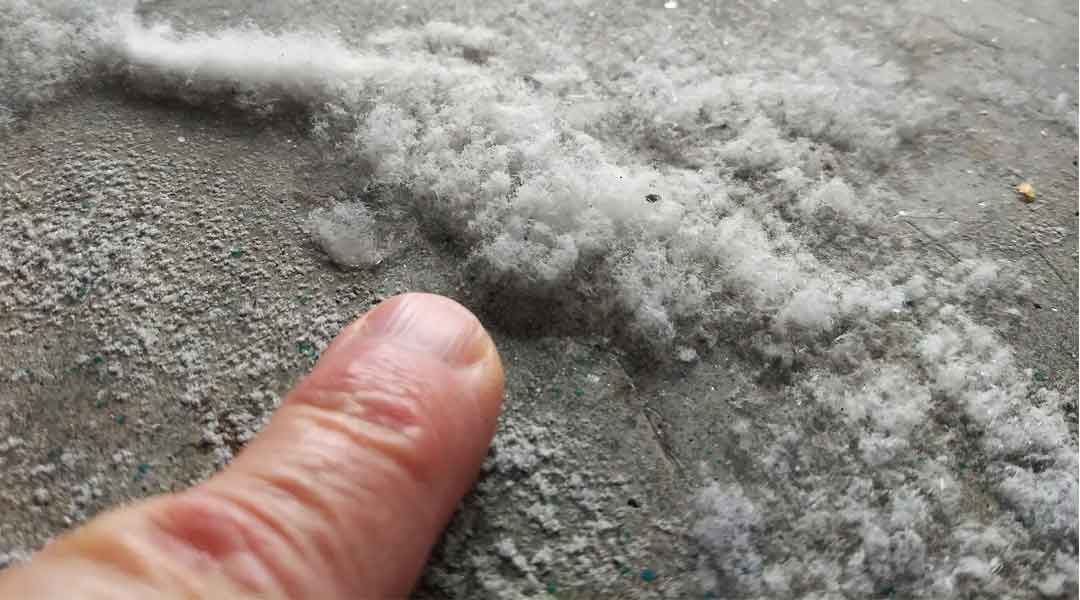
Efflorescence on Concrete, Brick, and Pavers: Causes, Removal, and Prevention
Efflorescence is that stubborn, powdery white stain that forms on concrete, bricks, and pavers. It’s caused by mineral salts being carried to the surface by moisture—and while it may look harmless, efflorescence can signal deeper water intrusion problems. In this guide, we’ll break down what causes efflorescence, how to safely remove it from masonry, and how to prevent efflorescence from returning using the right products and sealing techniques. Whether you’re dealing with a concrete patio, a brick wall, or paver hardscaping, this is your complete guide to keeping surfaces clean and protected.
The Basics of Efflorescence
Efflorescence is the unsightly, powdery white residue that forms on the surface of concrete, brick, pavers, stucco, and other masonry surfaces. It appears when soluble salts from within the material are dissolved by water and carried to the surface. As the water evaporates, it leaves behind a chalky salt deposit known as efflorescence.
The term comes from the French word meaning “to flower out,” and it can sometimes appear as fluffy, hair-like crystals. While white efflorescence is most common, salt stains can also be yellow or brown, depending on the minerals present.
Although usually a cosmetic issue, efflorescence can signal deeper moisture problems that may require attention.
✅ What Causes Efflorescence?
Efflorescence is caused by a combination of moisture movement and mineral salts. In order for efflorescence to appear on concrete, brick, pavers, or other masonry, three specific conditions must be met:
-
Soluble salts must be present in the concrete, mortar, or masonry materials.
-
Water must dissolve these salts and carry them through the material.
-
The salt-laden water must reach the surface and evaporate, leaving the salts behind.
Materials with high cement content—like concrete, mortar, stucco, and grout—contain the most soluble salts and are therefore more likely to develop efflorescence. However, it can also appear on clay brick and pavers when the source of salts is the cementitious mortar or bedding materials.
💡 Example: Efflorescence on red brick walls is often caused by water dissolving salts in the mortar joints. The salt solution migrates into the brick and exits through the face, leaving a white or powdery stain.
In addition to material composition, certain conditions during construction or weather exposure can increase the risk of efflorescence:
-
Excess water in the concrete mix
-
Use of calcium chloride accelerators
-
Poor curing practices or surface finishing
-
Frequent wet-dry cycles (like sprinkler spray or rain)
-
Hydrostatic pressure from groundwater pushing moisture inward
-
Cold, damp, or shaded areas with slow evaporation
Understanding the cause of efflorescence is the first step toward preventing it. Whether it’s rising damp in your basement or surface water on your patio, controlling moisture movement is key to stopping salt deposits from forming.
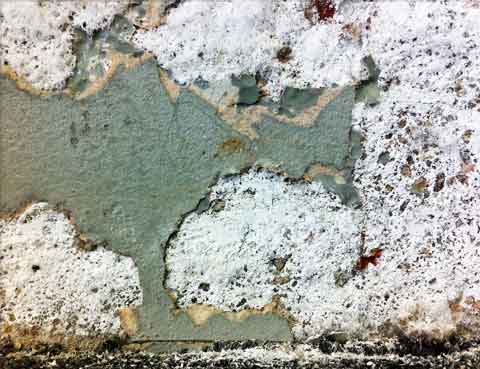
Efflorescence pushing paint off a garage wall.
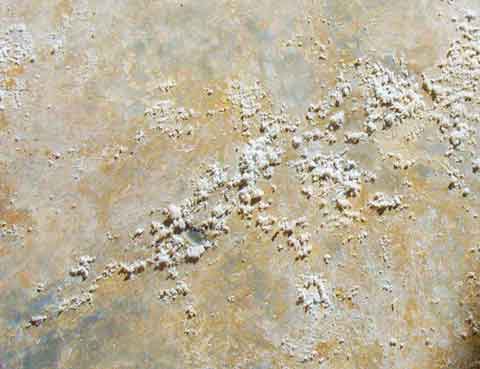
Efflorescence bloom on basement concrete floor.
USER-FRIENDLY
RadonSeal® Efflorescence Cleaner
__________
No harsh acids or dangerous chemicals! The safer, more effective efflorescence cleaner with homeowners in mind. About Our Cleaner.
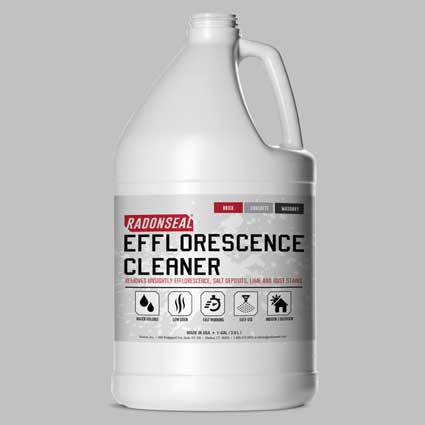
Removing Efflorescence On Concrete, Brick, & Pavers
Now that you’ve identified efflorescence on your surface, the next step is removing it effectively—without damaging your concrete, brick, or pavers.
While traditional acid-based cleaners like muriatic acid or hydrochloric acid can remove efflorescence, they come with major drawbacks:
-
Toxic fumes and odors
-
Skin and eye hazards
-
Potential damage to surrounding surfaces or vegetation
These harsh chemicals are difficult to use safely—especially for indoor projects or sensitive masonry.
✅ A Safer, More Effective Efflorescence Cleaner
RadonSeal Efflorescence Cleaner is a professional-grade solution designed to remove efflorescence from concrete, brick, and pavers—without the dangerous side effects of traditional acids. It dissolves and lifts stubborn salt deposits without harming your surfaces or releasing hazardous fumes.
It’s the best efflorescence remover for:
-
Basement walls
-
Garage floors
-
Brick walkways
-
Concrete slabs
-
Paver patios
For full instructions and product details, visit our Efflorescence Cleaner Product Page.
Types of Efflorescence in Concrete and Masonry
Efflorescence can appear at different stages in the life of concrete, brick, or pavers. Understanding the type of efflorescence is essential to selecting the right treatment method.
🔹 Primary Efflorescence: Common in New Concrete
Primary efflorescence forms during the initial curing phase of concrete or masonry products. It occurs when soluble salts within the material dissolve in water and migrate to the surface as the concrete cures.
For example, on a freshly poured concrete slab, Portland cement salts may dissolve into bleed water that rises to the surface. As the water evaporates, it leaves behind a visible white deposit—primary efflorescence.
This is most common in:
-
New concrete slabs and foundations
-
Freshly laid masonry
-
Concrete with added calcium chloride (for faster curing)
Builders may add excess water or curing accelerants, which increases the likelihood of efflorescence by introducing more moisture and salts into the mix.
Is It a Problem?
While primary efflorescence on new concrete is mostly cosmetic, it can:
-
Interfere with adhesives, paints, or overlays
-
Cause surface dusting or discoloration
-
Reappear if not properly removed before finishing
Fortunately, it often resolves itself over time, but it should still be cleaned before applying any coatings or flooring materials.
🔹 Secondary Efflorescence: Caused by External Moisture
Secondary efflorescence forms after concrete or masonry has fully cured, and is typically the result of external water sources introducing salts into or through the structure.
Unlike primary efflorescence, which originates internally, secondary efflorescence is caused by water penetrating from the outside, dissolving salts either from the surrounding soil or the masonry itself, and depositing them on the surface as it evaporates.
💧 Common Sources of Secondary Efflorescence:
-
Hydrostatic pressure from groundwater buildup around foundations
-
Rainwater, sprinklers, or irrigation systems saturating above-grade masonry
-
Repeated wetting and drying cycles, especially in shaded, slow-drying areas like:
-
Garage floors
-
Retaining walls
-
Shady patios and walkways
-
For example, in basements and foundation walls, hydrostatic pressure can push water through pores and capillaries in concrete or CMU blocks. As the water travels, it picks up salts from soil and cement, which are then left behind as white efflorescence when the moisture dries.
⚠️ Why It Matters
While secondary efflorescence on concrete walls or masonry is visually similar to primary efflorescence, it’s often a warning sign of a deeper moisture intrusion issue—not just a cosmetic nuisance. Left unaddressed, the underlying water problem can lead to:
-
Mold and mildew
-
Structural deterioration
-
Surface damage or paint failure
✅ Key Takeaway:
Secondary efflorescence is a symptom, not just a stain. If you see it on walls, slabs, or brick, it’s a sign that moisture management and waterproofing need to be addressed—especially in below-grade or poorly drained areas.
🔹 When Efflorescence Turns Into Calcium Carbonate
Efflorescence is water-soluble, meaning the white, chalky deposit can be temporarily removed simply by wetting it. A quick test to confirm efflorescence on concrete, brick, or pavers is to apply water to the stain—if it disappears while wet but returns once the water evaporates, you’re dealing with efflorescence.
However, over time, efflorescence can transform into a much harder deposit. As the salts on the surface react with carbon dioxide in the air, they convert into calcium carbonate (limestone). This hardened layer is not water-soluble, making it far more challenging to clean.
⚠️ Why This Matters
-
Calcium carbonate deposits cannot be easily removed by simple scrubbing or mild cleaners.
-
Stubborn build-up may require multiple applications of a specialized efflorescence cleaner, or in severe cases, mechanical removal (grinding, chiseling, blasting).
ECO-FRIENDLY
Penetrating Sealers for Efflorescence Protection
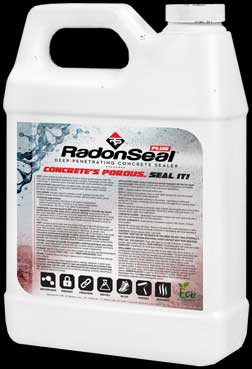
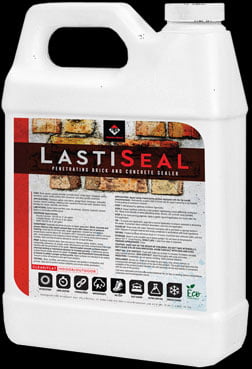
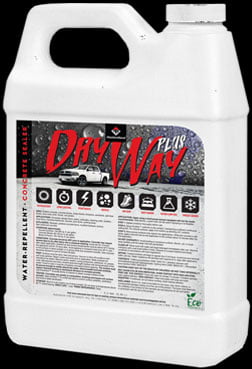
🛡️ Preventing Efflorescence in Concrete, Brick, and Pavers
Efflorescence on concrete, brick, and pavers can be stubborn. Cleaning visible stains helps temporarily, but unless you address the underlying causes, those white salt deposits will keep coming back.
To prevent efflorescence permanently, you must break the cycle by controlling two key factors:
-
✅ Eliminate or immobilize soluble salts
-
✅ Prevent water from delivering salts to the surface
🧪 Step 1: Control Soluble Salts in Concrete and Masonry
Efflorescence cannot form without soluble salts. These salts are naturally present in nearly all cement-based materials—like concrete, mortar, grout, and stucco—and even in some types of bricks and pavers.
If you’re working with new construction, you can minimize salt content by:
-
Using low-alkali Portland cement
-
Selecting well-graded aggregate
-
Maintaining a low water-to-cement ratio
-
Avoiding calcium chloride accelerators
-
Controlling evaporation during curing
Many manufactured pavers use additives to reduce salt mobility—but this varies by brand.
For existing concrete, brick, or block, the salt content is already locked in—but there’s still a solution.
✅ RadonSeal Deep-Penetrating Concrete Sealer chemically reacts inside the concrete to bind and immobilize salts, permanently preventing them from migrating to the surface.
Use RadonSeal to:
-
Seal deep within concrete, mortar, and stucco
-
Lock salts in place and stop efflorescence at the source
-
Prepare surfaces for paint, overlays, or adhesives
💧 Step 2: Manage Water – The #1 Way to Stop Efflorescence
Water is the vehicle that delivers salts to the surface. No water, no efflorescence. That’s why moisture management is the most effective way to prevent it.
Start by eliminating obvious water sources:
-
Redirect downspouts and adjust sprinklers
-
Repair gutters, flashing, and roof runoff
-
Fix grading around your home or foundation
-
Eliminate puddling on patios, walkways, or driveways
But what if you can’t stop the moisture?
That’s where sealing becomes critical.
🧱 How to Prevent Efflorescence on Brick, Block, and Concrete
When moisture intrusion is unavoidable—like in basements, retaining walls, or exterior masonry—use the right type of sealer to block water without trapping vapor.
⚠️ Avoid topical coatings (like acrylics, urethanes, or epoxy) on below-grade or damp surfaces. These can trap salt-laden moisture beneath the surface and cause peeling, blushing, or flaking.
✅ Instead, use breathable, penetrating sealers that repel liquid water but allow vapor to escape. These sealers keep the material dry without creating pressure buildup beneath the surface.
Best Sealer Options by Situation:
| Moisture Source | Best Sealer | Use Case |
|---|---|---|
| Below-grade hydrostatic pressure | RadonSeal | Basement walls, concrete slabs, retaining walls |
| Moisture wicking through brick or block | Ion-Bond Armor | Brick foundations, CMUs, stucco |
| Surface exposure (rain, sprinklers) | LastiSeal or DryWay | Driveways, patios, chimneys, walkways |
🔍 Key Takeaway: How to Prevent Efflorescence Long-Term
To stop efflorescence from returning, you need to:
-
Immobilize salts with a deep-penetrating concrete sealer
-
Prevent moisture intrusion from below, behind, or above
-
Choose the correct type of sealer for your specific moisture condition
By breaking the cycle, you can protect your concrete, brick, or paver surfaces from stains—and avoid the frustration of cleaning efflorescence over and over again.
How to Choose the Best Sealer to Prevent Efflorescence
When it comes to efflorescence prevention, the right sealer makes all the difference. But here’s the key: the best sealer for efflorescence depends on where the water is coming from.
Using the wrong type of sealer can actually make the problem worse. For example:
-
If moisture is pushing up from below a concrete slab or through foundation walls, applying a surface sealer (like acrylics, epoxies, or urethanes) can trap moisture inside.
-
As salt-laden water is forced to the surface by hydrostatic pressure, it becomes trapped behind the coating—causing white haze, bubbling, peeling, or even coating failure.
🔻 For Below-Grade Concrete or Rising Moisture:
If your water problem comes from the negative side—like underneath a slab or outside a basement wall—the safest solution is a deep-penetrating concrete sealer designed to resist hydrostatic pressure.
✅ Use: RadonSeal Deep-Penetrating Concrete Sealer
-
Permanently penetrates concrete and chemically binds soluble salts
-
Prevents water intrusion and stops efflorescence from within
-
Ideal for poured concrete foundations, slabs, and retaining walls
-
Leaves surface ready for paint, tiles, or flooring adhesives
🏗️ Sealing Brick or Non-Cementitious Walls?
Use Ion-Bond Armor Subsurface Elastomeric Sealer, a flexible, breathable waterproofing solution approved for below-grade use. It’s specially designed for brick, stone, and other masonry walls that can’t be sealed with traditional concrete products.
☔ For Above-Grade Walls, Patios and Hardscapes:
If the water comes from the positive side—such as rainfall, sprinklers, or surface runoff—you need a water-repellent sealer that keeps water out while allowing vapor to escape.
✅ Use:
-
LastiSeal Brick & Concrete Sealer – Penetrates deeply and offers up to 15 years of protection
-
DryWay Water-Repellent Sealer – A DOT-approved silane/siloxane sealer ideal for driveways, patios, and vertical walls
These breathable, penetrating sealers stop moisture absorption—the leading cause of surface efflorescence on bricks, pavers, and concrete walls.
✅ Summary: Stop Efflorescence at the Source
To prevent efflorescence on concrete, brick, or pavers, you need the right sealer for the job:
-
If moisture is rising from below → Use a deep-penetrating concrete sealer
-
If moisture is coming from rain or irrigation → Use a breathable water-repellent sealer
-
Never trap moisture with a film-forming surface coating in high-moisture areas
By understanding your moisture source and using the correct sealing method, you’ll break the efflorescence cycle—for good.